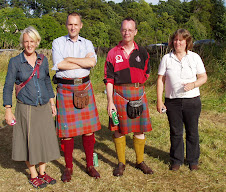Odds and ends, today.
No yarn from Jamieson & Smith yesterday (no post yet today) – I didn’t expect it to take even this long, and I am going to grind to a halt on the Calcutta Cup '06 sweater soon if it doesn't arrive (to coin a phrase).
Well spotted on my stitch-markers, Moorecat! My husband is much given to recycling. I have a little shot-glass on the coffee table containing markers – some real ones (I like the rubber ones Patternworks used to sell, maybe still does); some re-cycled, which he contributes; some curtain rings.
And, yes, quite a few stitches have been left behind at the underarm, to be grafted later. I’m working to Elizabeth’s Percentage System, first fully expressed in Knitting Without Tears. The number of stitches in the body is the basic number (“K”, for some reason) and the rule is to leave 8-10% of K behind at the underarm, on both body and sleeve of course. It’s quite a lot.
In my First Fair Isle Stage, in the 70’s, I worked out seamless-sweater-knitting for myself without having even heard of Elizabeth Zimmermann. I used to leave far fewer stitches behind at the underarm – or could it have been, none at all? The result was that the first couple of inches of the yoke were agonisingly tight to knit as one went around the sleeve. EZ’s way turns out to be perfectly comfortable. There’ll be quite a bit of grafting, but I positively enjoy grafting.
I got out Mrs Gaugain’s “Lady’s Knitting, Netting and Crochet Book” in pursuit of the discussion of the last couple of days, about old knitting terms. Again (as with Therese de Dillmont), she explains her abbreviations, and I don’t think it would be at all hard to follow them if one buckled down to it. Bishop Rutt says, by the way, that the abbreviations now in use were devised for Weldon’s Practical Needlework in 1906. The more I look things up in Rutt’s book, the more I admire it.
I looked up the Shetland shawl pattern I mentioned yesterday, in Mrs Gaugain's book. It’s the construction I wonder about here. It seems to be knitted from side to side, in one piece. It is edged with garter stitch – six rows to begin, and then six stitches at each edge as one proceeds; another six rows at the end. Finally, you’re meant to fringe it. The author says, most engagingly, “I shall endeavour to give a description of a knotted fringe…in the next following receipt; though I am doubtful I can explain it so as to be clearly understood by all knitters.”
Plus ca change…
It would be fun to try. I wonder if Sowerby has ever had a go at it. I might at least try to chart it one day.
Change of subject…
I had an email from Leigh Witchel this morning: very in-the-swim-of-things, me! He sought help with some articles he is writing, which I couldn’t provide, but the quest sent me to my Scandinavian shelf, and I was glad to be reminded again of Britt-Marie Christofferson’s “Swedish Sweaters”. It’s absolutely stuffed with interesting historical stuff, and sweaters I’d like to knit. One day.
Subscribe to:
Post Comments (Atom)




On your Scandinavian shelf do you have a little (thin) book titled Norwegian Knitting Designs by Annichen Sibbern Bohn? Published in Oslo in 1965. That's the book I used for my top down sweater mentioned earlier.
ReplyDelete